
|   |

|   |
50 years celebration of the 'Kuchipudi Flag' at the Indian Embassy, Washington - Manjari Sinha e-mail: manjari@sinha.com Photos: Shubhra Sinha January 11, 2025 The Indian Embassy, Washington DC, in association with Kuchipudi Kala Nilayam and the Kuchipudi Heritage Arts Society, recently celebrated 50 years of the Kuchipudi Flag. This function was conceptualised by Dr Vedantam Venkata Naga Chalapathi Rao as a precursor to coincide with the 'Kuchipudi Natyapathaka Swarnotsavam' (Golden Jubilee Celebration of the Kuchipudi Flag) celebrated at the Kuchipudi village, Andhra Pradesh, India from December 27 to 29, 2024. The year 2024 marked the 50th anniversary of the Kuchipudi flag, created by the hereditary Kuchipudi Guru Vedantam Parvateesam in 1974, who was inspired by Pingali Venkayya, the creator of India's national flag. This flag has a highly spiritual and metaphysical significance. The sugar cane stalk used as the flagpole represents the physical manifestation of the 'manas' or heart, where all art is born. This is inspired by the 10th 'Naamam' in Lalitha Sahasranamam - 'Mano Rupekshu Kodanda'. 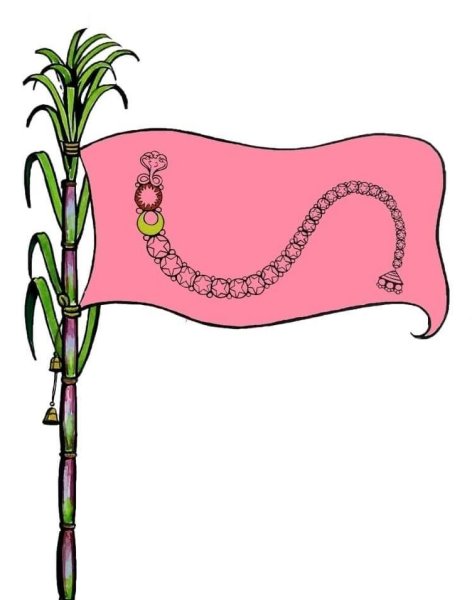 This sugar cane stalk has 10 nodes, which represent the ten 'Avasthas' or desires of a human being described in the Natya Sastra. The leaves above the sugar cane stalk represent the 'Sanchaari Bhavas', the emotions that contribute to Rasa. The pink 'Arunodaya' colour of the flag represents 'Chaitanya', the inner consciousness, because the art awakens our inner consciousness. Satyabhama's braid has been placed in the centre of the flag, representing the essence of the identity of the Kuchipudi art form. The entire universe is shown in this braid, including Sri Vishnu's Aadi Sesha, the Sun and Moon, the nine planets, the twenty-seven constellations of stars, and the three worlds. As a tribute to the 50th anniversary of this flag and Guru Vedantam Parvateesam's great contribution to the Kuchipudi art form, the Kuchipudi Heritage Arts Society organised a three-day festival in the Kuchipudi village in Andhra Pradesh, in December 2024. A 50-foot stupa was constructed for this festival, where the Kuchipudi flag was hoisted on this historical occasion. The festival featured dance performances, workshops, and seminars, where eminent Kuchipudi performers, scholars, and Gurus from across the globe participated. The Indian Embassy in Washington DC supported Kuchipudi Kala Nilayam and the Kuchipudi Heritage Art Society to organise the Kuchipudi program on this historical occasion. The remarkable feature of this program was the presentation of dance numbers that highlighted the salient features of this traditional dance style that originally flourished in the Kuchipudi village. There were excerpts from Kuchipudi Yakshaganam with 'vachika abhinaya', the 'Pravesha Daruvu' of dance dramas, the Kalapam and Shabdam et al. 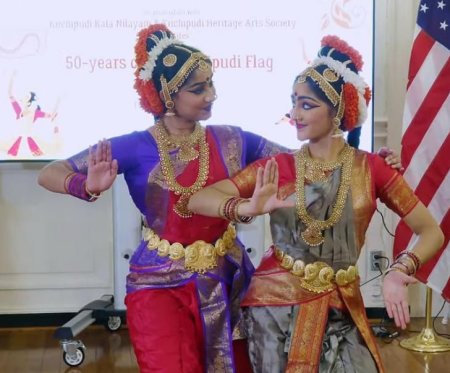 Vaishnavi Uppalpati and Jagruti Thrasu The opening with shlokas from Natya Sastra was followed with the invocation "Vande Vande Vaani Bhavani" composed by Vedantam Parvateesam and choreographed by the hereditary Kuchipudi Guru Pasumarthi Ramalinga Sastry, was a duet in celebration of 50 years of the Kuchipudi Flag. Performed by Vaishnavi Uppalpati and Jagruti Thrasu, disciples of Guru Lakshmi Babu, and sung by DSV Sastry in ragam Hamsadwani and adi talam, this invocatory duet was in praise of the Kuchipudi graama devata Goddess Bala Tripura Sundari, who is the embodiment of the Tri-Shakthi, Nava Rasas and the Chaturvidha Abhinayas. Kuchipudi's core element lies in its roots, the dance theatre tradition. This was focused next in the dance drama segment, an excerpt from the Kuchipudi Yakshagana 'Bhakta Prahlada'. The Sutradhar (storyteller) in Kuchipudi is traditionally a third person who weaves the story together and interacts with the audience. Here the storyteller (Sutradhar) engaged the audience with a preview of the story that ensued between Prahlada and his father Hiranyakasipu. This excerpt also highlighted the 'vaachika' or spoken element of Kuchipudi in the Pravesha Daruvu from Bhakta Prahlad Kuchipudi Yakshaganam, performed by Chinmaya Sindhu Vedantam, daughter and disciple of Dr. Vedantam Venkata Naga Chalapathi Rao and granddaughter of Vedantam Rattaiyah Sarma, the choreographer of this piece. The 'vachanam' (musically spoken dialogue) was in Ataana and the song was rendered in ragam Mohanam, talam adi. The 'Ramayanam Nritya Rupkam' performed by the versatile Dr. Yamini Saripalli next, was the unique aspect of Kuchipudi where both singing and dancing are performed together. Trained under Guru Vempati Chinna Satyam and Vempati Ravi Shankar, Yamini was equally adept in both, the Carnatic vocal and Kuchipudi dance, while singing and dancing to the lyrics by S.V. Bhujangaraya Sarma. Next came the Pravesha Daruvu, yet another characteristic feature of the Kuchipudi dance dramas, where sage Narada introduces himself upon entering the demon Bhasmasura's court. Ameya King danced the ashtapadi "Shrita Kamala Kuchamandala…" from Geeta Govind by Jayadeva. Traditionally the Sutradhar is a male character in Kuchipudi dance dramas but Guru Vempati Chinna Satyam innovatively used a female character or Sutradharini, to narrate Sakuntala's forlorn state and dismay when King Dushyanta fails to keep his promise. Guru Vempati Chinna Satyam also interspersed the verses with pure dance or nritta sequences in his choreography. This was performed by Dr. Yamini Saripalli to lyrics by S. V. Bhujangaraya Sarma, composed in ragam Abheri, talam rupakam. 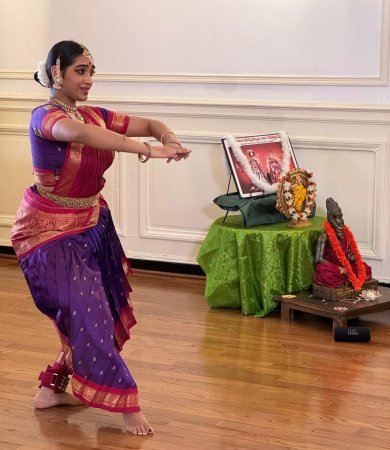 Pragnya Thamire To keep the drama aspect of Kuchipudi even within solo items, Kuchipudi has Ekaharya Abhinaya, where one dancer has the challenge of portraying multiple characters within the dramatic episode that features a lengthy sanchari within the piece. The solo piece flawlessly performed by Pragnya Thamire, the senior disciple of Guru Anuradha Nehru, brought this element efficiently in "Omkara Karini" written and composed by Dr. Balamurali Krishna in ragam Lavangi (also his creation) and choreographed by Jai Kishore Mosalikanti. The composition invoked Devi, the universal mother Goddess and the cosmic force. She destroys demonic threats to create equilibrium. She annihilates and recreates the universe, as exemplified in the story of 'Dhoomra Lochana' who, after arrogantly seeking her hand in marriage for his king, is killed by the mere vibration of her breath. The dramatic story was used as the sanchari. 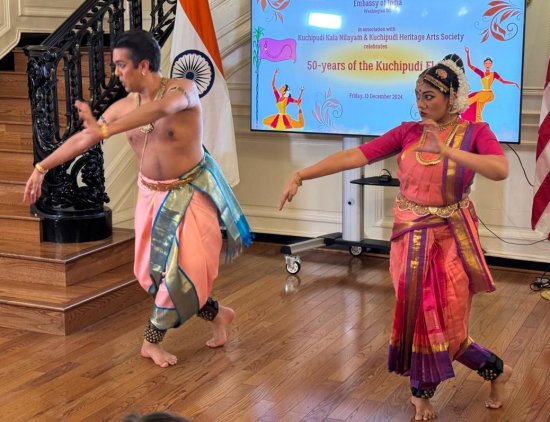 Kasi Aysola & Madhuvanthi Sundararajan in Dashavatara Shabdam The traditional 'Shabdam' came as the concluding item with the 'Dashavatara Shabdam' choreographed by Guru Vempati Chinna Satyam and performed by Kasi Aysola, disciple of Vempati Ravi Shankar, and his student Madhuvanthi Sundararajan. The Sanskrit shloka from Jayadeva's Geeta Govinda, an ode to the ten incarnations of Vishnu rendered in ragam Kalyani was followed with a song in Mohanam by Annabattula Veeraswamy. Mangalam was performed by all the dancers in the end. 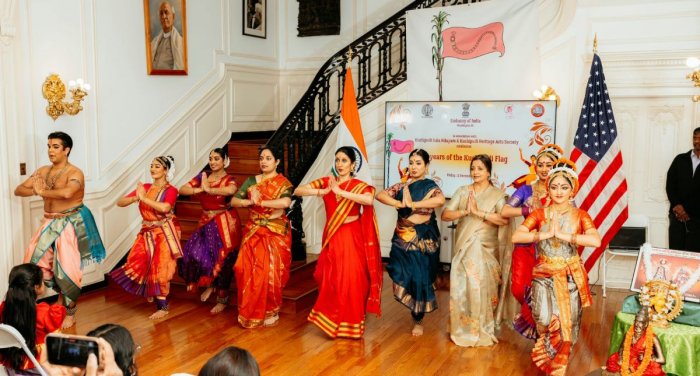 (Photo courtesy: Indian Embassy) 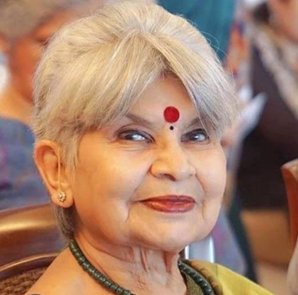 Manjari Sinha is a musicologist and an acclaimed classical music and dance critic. She has an MA in Sanskrit from Allahabad University, MA in Music from Vikram University, Ujjain; Sangeet Prabhakar in Hindustani Vocal, Tabla, Sitar and Kathak dance from Prayag Sangeet Samiti, Allahabad; and further training in Sitar under Guru Pt. Arvind Parikh in the lineage of Ustad Vilayat Khan. She has authored a book on Ustad Bade Ghulam Ali Khan, commissioned & published by Roli Books. She has contributed the chapter on Kathak for 'Indian Dance: the Ultimate Metaphor'. Her articles in English and Hindi on Music, Dance, Art & Culture are regularly showcased in a variety of leading journals and periodicals. |